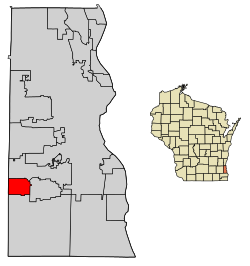|
Hales Corners, Wisconsin
Hales Corners is a village in Milwaukee County, Wisconsin, United States. The population was 7,720 at the 2020 census. A suburb of Milwaukee, it is part of the Milwaukee metropolitan area. HistoryThe land in the area that would eventually encompass the Village was first claimed as French, then British, and eventually as the Northwest Territory of the United States in 1783. It was the land of the Potawatomi Indians until they were forced to move from their land in 1838. They were the dominant tribe in southeast Wisconsin with large villages. Like the Europeans that arrived later, they planted crops, but theirs were beans, squash, and corn. By engaging in the fur trade, the Potawatomi learned to speak French and English, and they eventually intermarried with the Europeans. During the 1830s and 1840s, more settlers arrived, starting with a number of New England families. Among them were three Hale families, whose lineage has been charted to England in the 1200s. Hales Corners traces its history as a Village to 1837, when Seneca Hale laid claim to land here, and its name is credited to his brother William, who became its first Postmaster in 1854.[4] Hales Corners was the site of monthly fairs begun in the mid-1800's, when the plank road between Janesville and Milwaukee passed through the village. First a gathering of horse traders, the fairs became a stock market for farmers trading pigs, cattle, and sheep.[5] GeographyHales Corners is located in southwestern Milwaukee County. It is bounded by Greenfield on the north, Greendale on the east, Franklin on the south, and New Berlin and Muskego in Waukesha County on the west. According to the United States Census Bureau, the village has a total area of 3.22 square miles (8.34 km2), of which, 3.21 square miles (8.31 km2) of it is land and 0.01 square miles (0.03 km2) is water.[6] The elevation is 781 feet (238 m). Demographics
2010 censusAs of the census[3] of 2010, there were 7,692 people, 3,301 households, and 2,066 families living in the village. The population density was 2,396.3 inhabitants per square mile (925.2/km2). There were 3,505 housing units at an average density of 1,091.9 per square mile (421.6/km2). The racial makeup of the village was 94.7% White, 1.0% African American, 0.5% Native American, 1.7% Asian, 0.9% from other races, and 1.2% from two or more races. Hispanic or Latino of any race were 4.3% of the population. There were 3,301 households, of which 27.3% had children under the age of 18 living with them, 49.1% were married couples living together, 9.8% had a female householder with no husband present, 3.6% had a male householder with no wife present, and 37.4% were non-families. 31.6% of all households were made up of individuals, and 14.6% had someone living alone who was 65 years of age or older. The average household size was 2.31 and the average family size was 2.91. The median age in the village was 43.9 years. 20.8% of residents were under the age of 18; 8.2% were between the ages of 18 and 24; 22.6% were from 25 to 44; 29.9% were from 45 to 64; and 18.5% were 65 years of age or older. The gender makeup of the village was 47.6% male and 52.4% female. 2000 censusAs of the census[3] of 2000, there were 7,765 people, 3,260 households, and 2,122 families living in the village. The population density was 2,424.7 people per square mile (936.9/km2). There were 3,377 housing units at an average density of 1,054.5 per square mile (407.5/km2). The racial makeup of the village was 97.15% White, 0.22% African American, 0.49% Native American, 0.97% Asian, 0.04% Pacific Islander, 0.57% from other races, and 0.57% from two or more races. Hispanic or Latino of any race were 2.09% of the population. There were 3,260 households, out of which 27.4% had children under the age of 18 living with them, 53.8% were married couples living together, 8.5% had a female householder with no husband present, and 34.9% were non-families. 29.1% of all households were made up of individuals, and 12.6% had someone living alone who was 65 years of age or older. The average household size was 2.35 and the average family size was 2.93. In the village, the population was spread out, with 22.1% under the age of 18, 7.2% from 18 to 24, 28.1% from 25 to 44, 24.2% from 45 to 64, and 18.5% who were 65 years of age or older. The median age was 41 years. For every 100 females, there were 91.1 males. For every 100 females age 18 and over, there were 87.9 males. The median income for a household in the village was $54,536, and the median income for a family was $66,136. Males had a median income of $42,175 versus $33,237 for females. The per capita income for the village was $25,354. About 0.3% of families and 2.0% of the population were below the poverty line, including 0.6% of those under age 18 and 5.0% of those age 65 or over. EducationThe Whitnall School District serves Hales Corners.[8]
Private schools:
Post-secondary: Points of interest
Notable people
See alsoReferences
External linksWikimedia Commons has media related to Hales Corners, Wisconsin.
|
||||||||||||||||||||||||||||||||||||||||||||||||||||||||||||||||||||||||||||||||||



